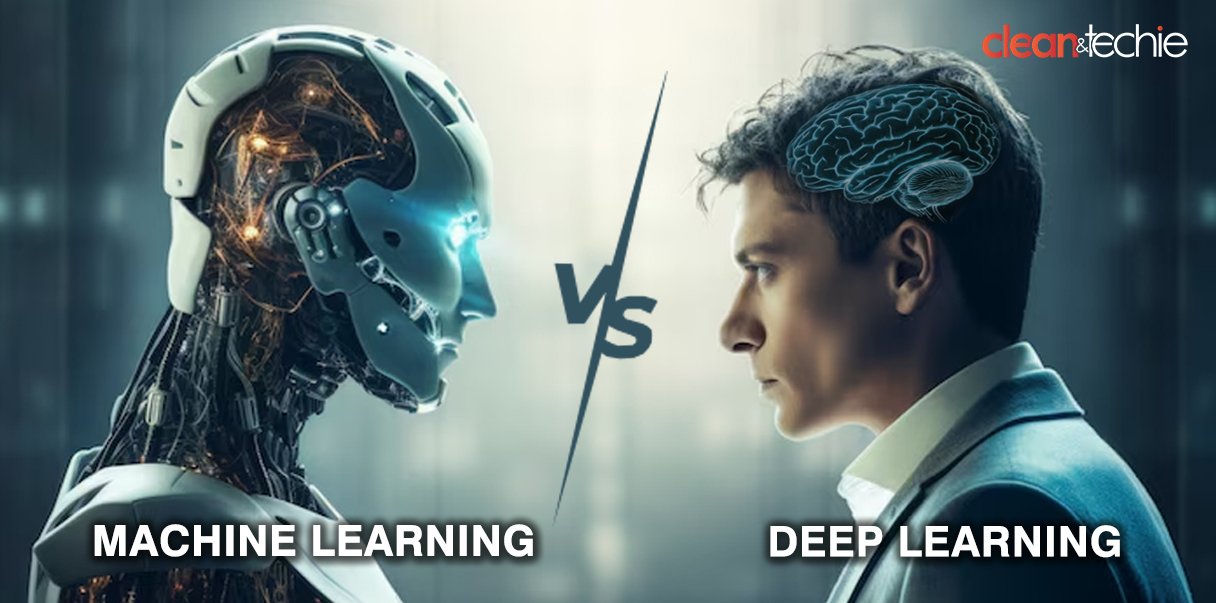Deep Learning vs Machine Learning – In today’s world of artificial intelligence, these two terms often intertwine.
While both are part of AI, they differ in their approach and complexity. This post delves into the distinctions between these two concepts, providing examples and insights into their applications.
Let’s get into more details:
Machine Learning
Machine learning is a core AI technique that teaches computers to learn from data. It helps computers identify patterns, make predictions, and solve problems. This versatile tool is used in many applications, from recommendations to medical diagnoses.
Supervised Learning:
Involves training a model on labeled data, where input features are paired with corresponding output labels. Examples of supervised learning include regression (predicting numerical values) and classification (categorizing data).
Unsupervised Learning:
Unsupervised learning is a machine learning technique that helps computers discover hidden patterns and structures within data without explicit guidance. This is useful for tasks like clustering similar data points together or reducing the complexity of data while preserving its essential features.
Reinforcement Learning:
Reinforcement learning teaches agents to make decisions in a dynamic environment to maximize rewards. It’s similar to reinforcing a desired response through positive reinforcement. Games like chess and Go, where agents must make strategic choices, are prime examples of reinforcement learning in action.
Deep Leaning
Deep learning uses artificial neural networks with multiple layers to learn complex patterns in data.Taking cues from the human brain, these networks function by passing information through interconnected nodes. As data passes through multiple layers, the network learns increasingly abstract representations, enabling it to handle complex tasks like image recognition and natural language processing.
Neural Networks:
Composed of layers of interconnected nodes, each representing a neuron. The input layer receives data, hidden layers process the information, and the output layer produces the final result.
Deep Neural Networks:
Deep neural networks have multiple layers. These layers help them understand complex patterns. Convolutional Neural Networks (CNNs) are good for images and videos, while Recurrent Neural Networks (RNNs) are best for things like text and numbers that follow a sequence.
Key Differences
The table below would outline the key differences between machine learning and deep learning, two prominent subfields of artificial intelligence.
| Feature | Machine Learning | Deep Learning |
| Complexity | Generally simpler | More complex due to multi-layered neural networks |
| Feature Engineering | Manual feature engineering is crucial | Can automatically learn relevant features |
| Data Requirements | Can work with smaller datasets | Often requires large datasets for optimal performance |
| Applications | Wide range of tasks, including regression, classification, and clustering | Particularly well-suited for tasks involving unstructured data, such as image recognition, natural language processing, and speech recognition |
| Interpretability | Often more interpretable | Less interpretable, especially for deep neural networks |
Applications of Machine Learning Vs Deep Learning
The following table presents a comprehensive overview of the applications of machine learning and deep learning across various industries.
| Application | Machine Learning | Deep Learning |
| Healthcare | Disease diagnosis, patient outcome prediction, drug discovery | Medical image analysis, drug discovery, personalized treatment plans |
| Finance | Fraud detection, credit risk assessment, algorithmic trading | Stock market prediction, risk assessment, fraud detection |
| Autonomous Vehicles | Object detection, lane keeping, decision-making | Object detection, image recognition, scene understanding |
| Manufacturing | Predictive maintenance, quality control, supply chain optimization | Predictive maintenance, quality control, defect detection |
| Customer Service | Chatbots, recommendation systems, sentiment analysis | Natural language processing for chatbots, personalized recommendations, sentiment analysis |
| Natural Language Processing (NLP) | Sentiment analysis, text classification, machine translation | Machine translation, language generation, text summarization |
| Image and Video Processing | Image classification, object detection, image generation | Image recognition, object detection, image generation, video analysis |
Conclusion
Machine learning and deep learning are two groundbreaking AI technologies that are transforming industries worldwide. Machine learning, the foundational technique, teaches computers to learn from data and improve their performance on specific tasks. Deep learning, a more advanced subset, employs complex neural networks to recognize intricate patterns in large datasets. Together, these technologies are revolutionizing fields like healthcare, finance, and autonomous vehicles. By understanding their unique strengths and limitations, practitioners can select the most appropriate method for their specific needs.
Machine learning and generative AI are two interconnected fields of artificial intelligence that have been making significant strides in recent years. Further, Machine learning and blockchain, though different, work well together. They help solve problems in areas like finance, healthcare, and supply chain management.




